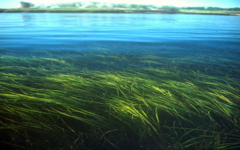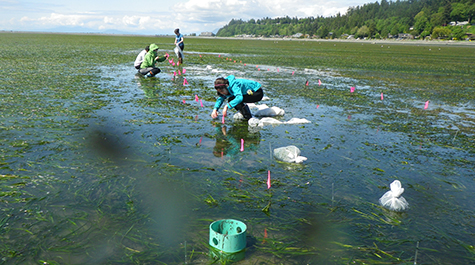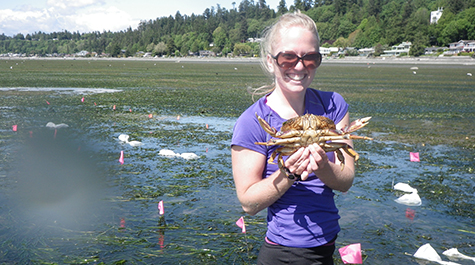Undergraduates embark on summer “ZENternships”
VIMS duo provide students with training, experience in marine ecology
Eight William & Mary undergraduates are engaged in a unique new research program led by the Virginia Institute of Marine Science that combines classroom experience with summer internships across the globe.
The two-part program is a part of the Zostera Experimental Network (ZEN), a collaborative worldwide project in which teams of scientists are using identical field methods to study the structure and function of eelgrass (Zostera marina) ecosystems at coastal sites in 11 countries from Korea to Portugal. Funded by the National Science Foundation, ZEN aims to better understand how and why seagrass ecosystems—important nursery and feeding grounds for many marine animals—might differ in their responses to changes in climate and biodiversity.
During the spring semester, the students completed Seagrass Ecosystem Ecology, a course led by VIMS Professor and ZEN’s Principal Investigator Emmett Duffy and VIMS Ph.D. student Jonathan Lefcheck. Held on the VIMS campus in Gloucester Point, the course included lectures on marine and seagrass ecology, reading and discussion of relevant literature, and training for the lab and field methods to be used during the summer research projects. Also contributing to the instruction were colleagues at the University of California, Davis and San Diego State University.
Duffy, head of the Marine Biodiversity Lab at VIMS, has since last June been splitting his time between the Institute and his new position as director of the Smithsonian’s Tennenbaum Marine Observatories. He says the internship program—and ZEN in general—are revolutionary projects that represent a new model for integrating research, active learning, and international collaboration.
In an effort to communicate the intern’s summer experiences to a wider audience, Duffy and Lefcheck have asked them to write blog posts for the official ZEN blog. Each student will be discussing their research projects from their host institutions in Canada, Croatia, Portugal, Massachusetts, New York, North Carolina, and California, as well as posting their photos to the ZEN Flickr page.
Pamela Reynolds, VIMS postdoctoral researcher and project manager for ZEN, plays an intricate role in the classroom and internship portions of the program. She serves as the editor for the student’s blogs in addition to developing the syllabi, lectures and activities for the three Seagrass Ecosystem Ecology courses being taught simultaneously at VIMS, UC Davis and San Diego State University.
Reynolds says the distributed course concept—where undergrads from the three universities experience hands-on training and interact within and across classes—is really novel. “Coupled with the summer internship, this program is exciting for both the students and the research partners,” she says. “We’re at the cutting edge of undergraduate STEM education.”
ZENterns
The eight interns—or “ZENterns” as they call themselves—had to meet a series of requirements in order to enroll in this unique course. In addition to completing the course prerequisite—Introduction to Marine Science—all of the students were required to be physically fit, good swimmers, personally mature, and prepared to work with diverse teams of people. The students were also required to take part in an interview with Duffy, who made the final selection.
David Godschalk ‘14 is currently interning at the University of Zadar in Croatia. He says the reality that Earth is reaching its limits and is on the brink of potentially irreversible change is what drove him to enroll in the course. The geology major says the course gave him an in-depth look at the problems our planet is facing, like climate change, urban and agricultural runoff, and habitat destruction.
“The stressors being put on our planet heavily affect ocean systems, and seagrasses are just one of the many endangered habitats,” says Godschalk. “I’ve always been fascinated with marine science and this course seemed like a unique way to combine my interests.”
This summer, Godschalk is conducting field experiments to determine the degree to which herbivores in seagrass beds feed on the grass itself as opposed to other associated plant matter. “The research I’m doing in Croatia is important because seagrasses fight with microalgae for the right to photosynthesize to survive,” he says. “If grazers feed preferentially on seagrass instead of algae, that can determine the whole dynamic of the system and affect a species’ survival.”
ZENtern Kyle Belfort ‘15 is interning at San Francisco State’s Romberg Tiburon Center for Environmental Science. He has joined Kathy Boyer’s lab for their Cosco Busan eelgrass restoration project—an on-going effort to restore seagrass habitat lost during the Cosco Busan oil spill in 2007.
In addition to Belfort’s work as a ZENtern, the biology and environmental science and policy double major is also working on a summer research project as a part of W&M’s James Monroe Scholarship Program for academically distinguished undergraduates. Less than 10% of W&M undergrads receive the prestigious title of a Monroe Scholar.
“For my Monroe summer research project, I’m assessing the effect of increasing temperatures on the mortality of mesograzers in order to capture the effect of global temperature rise on the seagrass epifaunal community,” says Belfort.
Belfort says he hopes to gain as much experience as possible in the field of restoration, and he expects to develop further appreciation for scientific research during his summer in California. “In general, the class portion of the program gave me the background necessary to navigate the field of seagrass ecology,” he says. “The scientists I’m working with in my internship expect me to have a certain level of understanding of their work, and without this course I would have been lost.”
ZENtern Danielle Hall ‘15 completed the first installment of her summer research in Vancouver through the University of British Columbia, and is currently interning outside of Boston at Northeastern’s Marine Science Center in Nahant, Massachusetts. Hall is working alongside a post-doc, master’s student, and another ZENtern from San Diego State, collecting grazers from the field and giving them either seagrass (Zostera) or seaweed (Ulva) to determine which they prefer.
“I’ve already learned so much from this program,” says Hall, who has wanted to pursue a career in the field of marine science since she was five-years old. “I’ve learned how to take on a leadership role in a field experiment, how to troubleshoot in the field when having to make due with missing lab equipment and fast-changing tides that rush in during our work, and how to communicate with scientists—from undergrads to PIs—and I hope to stay in touch with many of the people I have met through this experience.”
Hall—a biology major enrolled in the marine science minor at W&M—says the classroom portion of the program helped prepare her for the unexpected. “Many of our experiments would turn awry due to environmental factors—like the very cold spring we had—and we would have to improvise in order to get results,” she says. “We were also able to familiarize ourselves with the majority of the procedures for the experiments we would be conducting this summer.”
The remaining W&M ZENterns—Charlie Deaton, Allison Farnan, Kara Gadeken, Austin Ruhf, and Jessica Viss—are conducting field studies in Croatia, Portugal, New York, and North Carolina.
With many of the ZENterns wanting to pursue careers in the field of marine science, they also benefited from discussing continuing education with Lefcheck. “One of the benefits of the internships is that the students have the opportunity to make professional connections with potential mentors at their host universities, or with others involved in the network,” he says.
Marine Science Minor
Faculty in the School of Marine Science at VIMS partner with Arts & Sciences at the College of William and Mary to offer W&M undergraduates the opportunity to minor in marine science. The undergraduate minor in marine science provides interested students a coherent experience in this interdisciplinary subject. A total of 18 credit hours are required, which includes 2 required core courses, 3 Marine Science Fundamentals courses, plus 6 additional elective hours. Courses are held at both the Williamsburg campus of W&M as well as the VIMS campus in Gloucester Point and field locations.




